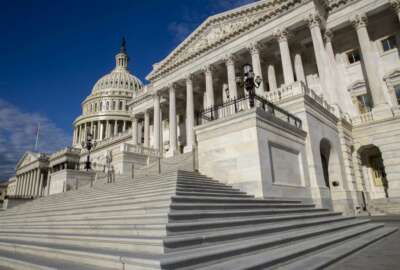The jury still is out on whether the Senate will pass the House’s “minibus” of spending bills, but a new report from the Office of Management and Budget guarantees sequestration if the fiscal 2018 numbers are approved without changes.
OMB’s sequestration update warns if 2018 caps are not changed, the House’s Make America Secure Appropriations Act would trigger spending cuts put in place under the 2011 Budget Control Act.
“If the 2018 discretionary caps remain unchanged, this report estimates that, if enacted, the actions to date by the House of Representatives would result in a sequestration of $72.4 billion in the defense category,” OMB said. “The report also finds that action or funding guidance in the Senate, if enacted, would result in a sequestration of $2 billion in the defense category and a sequestration of $3.8 billion in the non-defense category under the current 2018 spending limits.”
The House of Representatives passed the minibus in early August, shortly before leaving for summer recess.
The Senate appropriations committee has passed six of the 12 regular appropriations bills, including ones for agriculture, the legislative branch, and a bill for veterans and military, which are separate appropriations from defense.
The legislation includes $658 billion in total funding for the Defense Department, which counts $584 billion in discretionary spending and nearly $74 billion toward the Overseas Contingency Operations fund. The 2018 minibus appropriates DoD at $68 billion higher than 2017 enacted levels.
OMB’s report updates its May sequestration preview report. The report made no changes to 2017 or 2018 spending caps because “there have been no events since the 2018 preview report was issued that would trigger any cap adjustment,” the report said. “The report does, however, list anticipated adjustments to the 2018 limits based on requested amounts in the administration’s 2018 budget.”
President Donald Trump’s budget proposed $607 billion in defense discretionary spending and $560 billion in non-defense discretionary spending for 2018.
“While this report estimates that congressional action to date would trigger a sequestration, this does not reflect administration policy,” the OMB report stated. “This administration strongly supports restoring America’s investment in defense. To ensure that our military is not rebuilt on the backs of future generations of Americans, however, the administration strongly supports fiscally responsible reductions to spending elsewhere in the federal budget, as outlined in the FY 2018 budget request.”
The administration’s budget proposes further non-defense discretionary cuts by 2 percent over the next 10 years to balance the budget by 2027. Non-defense agencies are supposed to find those savings in their reorganization plans and reduction in the federal workforce.
The legislation includes $3.6 trillion in spending reductions to reach a balance within 10 years. It cuts publicly held debt to 60 percent of the gross domestic product.
Spending disagreements
Federal News Radio reported earlier this month that the minibus is not likely to pass the Senate without changes, in part because the chamber’s Democrats won’t agree to a spending bill that only boosts defense spending.
“Yes, the president wants to cut domestic appropriations dramatically and put that money into defense, but they don’t have the votes for that,” said Steve Bell, a senior adviser with the Bipartisan Policy Center.
David Berteau, CEO of the Professional Services Council, said there isn’t necessarily blanket disapproval of higher defense spending, but there’s no agreement on how to fit it under the spending caps.
“We’ll know the answer by the end of December, and I think the answer is going to be increases in defense and non-defense that will make neither Democrats nor Republicans entirely happy,” Berteau said. “But there will be … either a repeal or substantial increases in the sequester caps.”
The Congressional Budget Office said in its sequestration update that agencies won’t face cuts in the final weeks of 2017, but also warned that if Congress adds any new appropriations before Sept. 30, discretionary budgets would need to be scaled back.
Copyright
© 2024 Federal News Network. All rights reserved. This website is not intended for users located within the European Economic Area.
